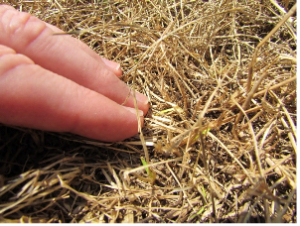There are volumes written to tell you how to have that vigorous green lawn. Pick up a garden magazine or newspaper article, read the print, look at the paradisiacal pictures, putting you in a hammock sipping lemonade. These publications are swaying you to purchase their products for healthy lawns or how their products can cure your lawn’s ills. Let me make this clear, there is a time and place to use the proper amounts of these chemicals, the arrows in our quiver (arsenal). A person once told me to use everything in moderation.
How to kill your lawn or more likely to stress your lawn.
(1) Encourage winter injury by late fertilizing with high nitrogen fertilizers. Recently, I visited a yard near Lake Murray, SC where 90 % of the centipede turf grass was dead. The landscaper applied heavy doses of a high nitrogen fertilizer in the fall on newly installed centipede sod.
(2) Encourage your grass to have short stubby roots in the spring and summer pre-emerge herbicides, the critical time when your lawn needs water and plant nutrients. Most pre-emerge herbicides prevent root cell division and elongation if excessively applied to lawns. How do you think pre-emerge herbicides kill weeds. They prevent weed germination by interfering with the developing root emerging out of the seed coat. The best time to apply a pre-emerge herbicide for winter weeds is as close to September as possible. The safest time to apply a pre-emerge herbicide for spring and summer weeds is between the blooming dates of forsythia (yellow bell) and dogwood trees. These dates are very important because the pre-emerge herbicide will have done its work and break down before the turf grass begins to send out stolons (runners), May through July, producing new roots.
(3) Watering too much or watering at the wrong time of day, encourages the growth of pathogenic fungi. Centipede on sandy soils needs about 1.5 to 2 inches per week, during the growing season, while centipede growing in clay soils need about 1 to 1.5 inches of water. These numbers are not gospel, but something to go by. If you want to have a fungus problem, prolong leaf blade wetness by watering in the late evening hours and shortly after sun rise into midmorning.
A note in ending. I worked as a teenager at the Clemson Experiment Station and I remember help digging centipede grass clumps from beneath black jack trees on a hill side behind the equipment barn. This area was about an acre. This grass was sold to the public for about a dollar per bushel. It had had no cultural attention and was growing vigorously there since the 1930 s or 1940 s. Of course, the manure tea from the mule barn may have helped. However, no commercial fertilizer, no pre-emerge herbicide and no irrigation. Now, isn’t that something ?






